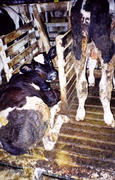The Facts
FarmingTo save farmers money, hundreds of animals are kept in cramped, unsanitary conditions, many never getting to see the outside world. Due to the bad conditions, many animals quickly
catch diseases and are left to carry on living with healthy animals who inevitably later catch the diseases themselves. Farmed animals are also killed young as this makes for tender meat, if they haven’t already dies from the conditions in which they’re kept. With a rota of 500 animals to kill a day, abattoir workers have to work quickly, often resulting in animals not being stunned properly before their throats are slit and they’re therefore left to bleed to death, often for hours.In order for an animal to be classed as ‘free-range’, their treatment needs to adhere to certain standards, which, unfortunately, most people still wouldn’t consider a pleasant standard of life. Hens, for example, are allowed access to the outside but as there are so many crammed into one shed, very few get to the outside or break ligaments or die in the process.Milk and EggsAs with any other mammal, cows need to be impregnated in order to produce milk. As dairy and beef cattle are so different, male cows produced as a by-product of milk, are seen as surplus and are simply killed immediately or sent to be used as veal. The calf is immediately separated from their mother so that we can use the milk while they are fed a substitute.As with cows, male chicks are considered surplus; they cannot be used for meat and can’t provide eggs and are therefore ‘shredded’ (fed into a machine that shreds them alive) or gassed.
Leather and FurLeather and fur is sometimes said to be a meat by-product. Leather products aren’t cheap and make as much money as meat for farmers; they dye used on the coats is also tested on animals. Fur farmers want an animal’s fur to be as long as possible, whereas they want animals killed for meat to be as young as possible. The bodies of animals killed for fur are discarded after the animal has often been skinned alive so that the fur can stay as ‘springy’ as possible.VivisectionAs many as 500 animals are killed a day due to vivisection; two thirds of these animals are given no anaesthetic during the procedure. As well as the obvious moral implications of animal experiments, there’s a lot of evidence to suggest it could be detrimental to human health given the difference in diseases that affect humans and animals and the entirely
different methods our bodies use to deal with these diseases (please see ‘health’ section). There’s also a huge range of far more effective methods to finding cures such as microdosing, DNA chips, microfluidics chips, human tissue, computer models, autopsies, epidemiology, stem cell research, new imaging technologies, post-marketing drug surveillance and clinical research. It is illegal to test cosmetics on animals in the UK but, many brands have cosmetics tested on animals abroad and then imported to the UK. Generally, supermarket own-brands aren’t tested on animals and will carry the ‘not tested on animals’ or ‘BUAV approved’ label, otherwise most brands have unfortunately been tested on animals.Seafood
Lobsters, prawns, shrimps, crayfish and crabs are all usually killed in the particularly inhumane method of being boiled alive. There is a lot of evidence to suggest that all these animals are capable of feeling as much as any other animal and they are known to scream when they are put in the boiling water; it’s a horrific way to die and completely unnecessary. Invertebrate zoologist Karen G. Horsley said of lobsters who are cut in half while still alive (another, less used, killing method), "The lobster does not have an autonomic nervous system that puts it into a state of shock when it is harmed. It probably feels itself being cut. ... I think the lobster is in a great deal of pain from being cut open ... [and] feels all the pain until its nervous system is destroyed during cooking.”
